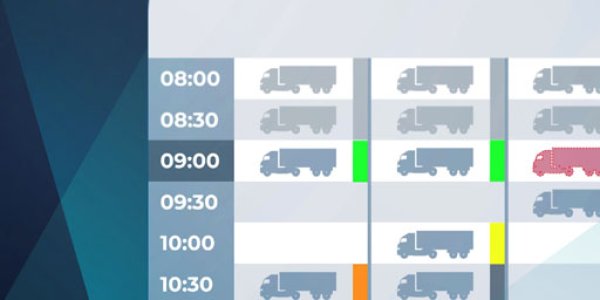Time slot management involves much more than simply managing appointments in an online calendar. As the name suggests, it is about the management of time slots - this also includes the forward planning of loading and unloading processes. If the added value of time slot management systems is often described with phrases such as "avoid traffic jams at the entrance" or "speed up the handling of trucks", the possibility of appointment scheduling based on capacities often falls by the wayside.
At myleo / dsc we call this process "capacity-driven time slot management". In practice, capacities are usually planned in a warehouse management system (WMS), such as SAP EWM. Thus, rolling weekly planning often takes place based on the available resources. In this context, resources are to be understood as physical resources such as space, forklifts and shuttles in the high rack. Furthermore, staff scheduling takes place based on these resources, so that the activities can also be processed accordingly.
The resulting planning, which can be adjusted on a rolling basis according to requirements, must now be made available to time slot management so that slots can be booked taking into account the available information. This should happen automatically and loading or unloading zones should onliny be able to be booked basedon these capacities. Therefore, any overbooking, which among other things leads to traffic jams in front of the factory premises and long waiting times, should not be possible in the first place.
However, practice shows that booking a time slot is often more like a declaration of intent and the reality is usually different. It is therefore crucial to integrate real-time information so that any deviations are known at an early stage and are available to gate management and the warehouse. This is precisely where the practical advantages of the combination of SAP EWM and myleo / dsc are hidden.
Capacity planning takes place in SAP EWM
The feature for capacity planning in goods receipt and issue in SAP EWM provides, among other things, an overview of expected and realised goods receipts and issues. On the basis of this capacity information, the warehouse employees are supported in planning the optimal utilization of the goods receipt and issue capacities. In addition, the feature provides an overview of the number of free storage bins grouped by type and supports the disposition in prioritising purchase orders or sales orders. This in turn facilitates planning with regard to the resources needed to process the pending warehouse tasks.
Planning is done - now myleo / dsc comes into play
myleo / dsc now goes one step further. Capacity planning can be integrated into myleo / dsc via an API based on locations and time slot resources (e.g. gates) from SAP EWM. In this way, the time slots to be booked are available according to the real capacities, including dynamic time slot lengths. By integrating real-time data, the actual arrival time (ATA) of a truck can be determined more precisely and follow-up activities can be derived. The information is also transparently available in SAP EWM and can, for example, be directly integrated into the TU (Transportation Unit). This also eliminates a media break for the end users and the required information is always available. This allows the staff to see when the truck will arrive at the factory site and to prepare the goods receipt or goods issue zone for the delivery.
SAP EWM + myleo / dsc: valuable advantages in the goods receiving process
The employees on the production line are waiting for urgently needed material. This has been ordered, notified and the time slot required for unloading based on capacity has been booked. The system makes the information that the material should arrive at time X visible right in the booking of the time slot in the TU or the delivery. Thus, the staff can already start the set-up process to prepare the corresponding machine for production. As soon as the material is unloaded in the goods receiving area, it can be brought directly to the production line with a warehouse task. In this way, logistics are directly integrated into production and throughput times are sustainably reduced.
This solution also offers great benefits for other internal processes. The employees have the opportunity to better plan their daily work and to prioritise free storage space capacities with urgent orders. If there are deviations in the incoming goods, these are not only visible but deeply integrated into the process and set-up work or production tasks, as shown in the example above, can be rescheduled at an early stage.
What possibilities arise for the outgoing goods department
In the outgoing goods department, the information is also available to all process participants and time slots for picking up goods are booked based on free capacities. The warehouse staff can see when the truck is due to arrive at the yard and can thus start picking the goods from the warehouse in advance and make them available at the door just-in-time. The shipper can load the goods faster and thus minimise waiting times. This not only has advantages for the forwarder, but also for you as the shipper: The material gets on its way to the consignee faster. In addition, you can increase your loading capacities per day many times over, which ultimately gives you the opportunity to increase your sales.
The entire process can be expanded modularly using the Process-as-a-Service platform myleo / dsc. For example, the integration of yard management offers the advantage of also embedding the route from the gate to the physical loading or unloading location in the process. Based on this, the call-off of the truck can be triggered directly from SAP EWM. The driver can be notified via a Progressive Web App (PWA) and navigated around the factory premises. By means of a no-code app configuration, it is possible to digitalise, manage and confirm activities related to loading or unloading. The myleo / dsc provides all activities with time stamps so that you can subsequently identify optimisation potential based on strategic reporting. Other upstream and downstream process steps, such as transport allocation, notification by suppliers or dispute management, round off the process platform.

